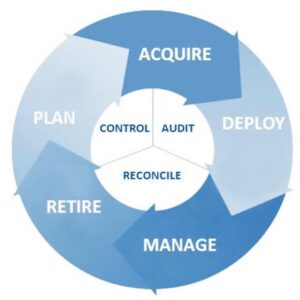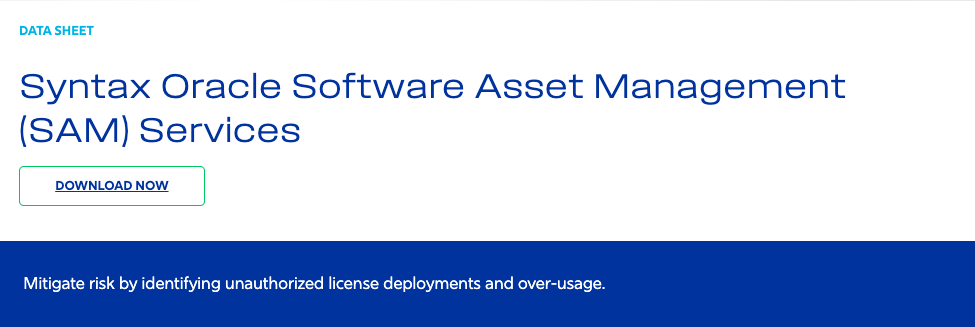Software is the backbone of any business, driving critical areas like innovation, security, performance, and productivity. But what happens when we inefficiently manage the software that makes us efficient?
Left unchecked, the very software needed to run our critical business systems can become the source of significant contractual licensing compliance liability, incurring financial penalties, wasted spending, and busted budgets. For Oracle users in particular, Oracle license management can be a minefield of complexity, where even small oversights can lead to costly consequences.
The Risks of Poor Oracle License Management
For example, let’s say Oracle EBS, along with its suite of middleware and database technologies, is the backbone of your business operations. But the pace of business causes you to lose track of what’s been deployed, where it’s running, and what you’re actually licensed to use. Suddenly, the risk of being non-compliant during an Oracle software audit isn’t just a distant possibility—it’s an urgent problem.
Without proper license management, maintaining software compliance can quickly become a source of inefficiency and financial strain. You could find yourself over-consuming more than you are contractually entitled to use, and/or you could find that you are over-paying for software and related support that you are not using.
Mismanagement of vendor agreements is a very common problem that many organizations deal with on a regular basis. Many organizations are caught off guard by ever-changing, complex contract terms related to virtualization, public cloud platforms, production use vs non-production use, multiplexing, and a variety of metrics that are used by vendors to establish licensing entitlements.
More alarmingly, market data is showing that the number and frequency of software vendor audits are on the rise since 2023, as well as the average value of financial penalties.
According to a 2025 Unisphere Research survey, 62% of organizations reported being audited by major software vendors in the past year, a 22% increase from the prior year. Nearly one-third incurred costs that exceeded $1 million.
The struggle is real. Software vendors have a right to defend their position of being paid by customers who use their software. Customers can’t always control who and how software is being used. Accidental software use and intentional software use scenarios play out in every organization.
The Complexities of Oracle Licensing Management
Oracle license management is particularly challenging due to its intricate terms, complex licensing rules, and ever-changing metrics.
One major issue is unintentional over-consumption. It’s easy to exceed licensing limits, particularly in fast-evolving IT environments, leading to unbudgeted costs in the form of fines and back-fees. There are no built-in controls that constrain the software to prevent new modules from being implemented or prevent an organization from adding new users. Also, there are very complex core-translation factors for deploying Oracle software on different public cloud environments.
On the other hand, underutilized licenses—sometimes called “shelf-ware”—are a common drain on budgets, failing to deliver a return on investment. And these will not be flagged by Oracle, although an Oracle software audit would reveal the gap in actual vs contracted.
Oracle’s rules around virtualization, recovery, and multiplexing introduce further complications. For example, using virtualization platforms like VMware or Nutanix, or migrating workloads to non-Oracle cloud platforms, can trigger compliance issues.
Oracle software license audits can result in unexpected budget spending including license fees, support fee increases, fines, and legal fees—averaging $10 million for large enterprises and up to $1 million for smaller organizations.
What are the most common triggers of Oracle software audits and non-compliance?
What can you do to ensure good software license management?
Software asset management (SAM) is a strategic process framework designed to help organizations manage, optimize, and control their software assets. A strong SAM approach involves tracking software license entitlements—often buried in complex contracts—against actual usage over time and change events. This data is then aligned with tailored risk mitigation strategies that fit your business needs, reducing cost exposure and keeping your organization out of the audit spotlight.
SAM Framework:

Essentially, a properly designed and implemented software asset management process framework serves as your single source of truth to unite the reality of entitlements vs consumption over time. Your software asset management plan should help you:
- Gain a clear understanding of license entitlementscompared to actual usage, highlighting financial risks and under-utilization of Oracle resources and avoiding surprises during audits
- Mitigate financial and operational risksby identifying unauthorized deployments and over-usage, keeping your organization protected from non-compliance penalties
- Gain a comprehensive view of software usage and inventory to optimize licensing and IT investments
- Validate internal controls to maximize the value of Oracle resources
- Establish clear processes to balance financial accountability and regulatory compliance
“A well-implemented SAM strategy balances financial accountability, regulatory compliance, and resource optimization. In today’s rapid evolution of technology, the manner in which software is sold, managed, and measured will also continually change. The key to success is how you keep pace.”
– Rich Froble, Director, Global Product Management, Syntax
Why Partner with an External SAM Provider?
While it’s possible to manage software licenses internally, partnering with an external software asset management provider offers significant advantages. These experts bring specialized knowledge, tools, and a data-driven approach to simplify the process of license management, non-compliance risk mitigation, and cost-optimization.
Seeking the expertise of an external SAM provider is particularly valuable for Oracle customers as they can navigate the complexities of Oracle’s licensing terms and provide unbiased, confidential guidance on successful mitigation strategies.
Whether you need a one-time advisory project or ongoing managed services, a trusted SAM partner can tailor their offerings to meet your specific needs. From optimizing your license usage to defending against audits, their expertise ensures you’re well-prepared for any challenges.
Conclusion
Effective license management is about more than avoiding costly Oracle software audits—although that’s very important. It’s about maximizing the value of your software investments, ensuring compliance, and driving business efficiency. For Oracle users, whose licensing terms are especially complex, a robust SAM strategy is essential to staying ahead of potential risks.
As Benjamin Frankin once said, “Failing to plan is planning to fail.”
Authors

Rich Froble
Director, Global Product Management, Syntax
Rich Froble is an experienced product management executive with over 25 years of success in developing and managing high-growth managed service solutions across enterprise applications, SaaS enablement, and cloud services.


